Saturday, December 14, 2019
Sunday, December 08, 2019
Ice Crystals
One of my staff (thanks Barb!) stopped by my office to tell me there were nice ice crystals that I might want to take photos of. (They know me well!)
The ice crystals turned out to be on the side of the smoking shelter outside. It's unheated, a bit like a bus shelter but more enclosed. (Considering Saskatchewan winters, you have to really want your nicotine these days.)

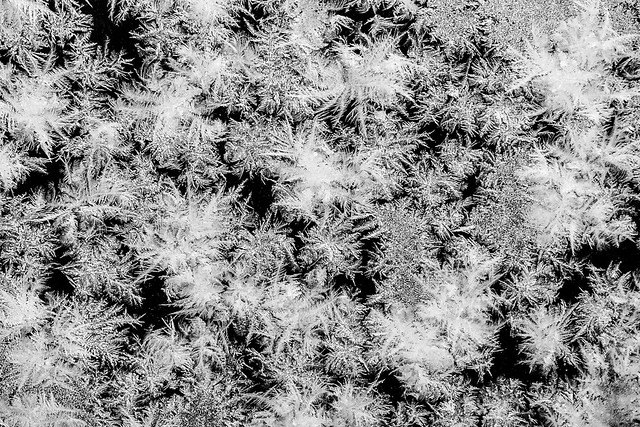


The details are interesting if you get a chance to look at them on a larger screen.
(Click to view larger.)
There were crystals on the inside and the outside of the glass, making it problematic to get both in focus. And it was hard to make a decent background out of a parking lot. Wide angle would give the best depth of focus but the worst background, so these were all token at full zoom on the little ZS100 (250mm equivalent) They're converted to black and white in part to make the background less distracting.
The ice crystals turned out to be on the side of the smoking shelter outside. It's unheated, a bit like a bus shelter but more enclosed. (Considering Saskatchewan winters, you have to really want your nicotine these days.)




The details are interesting if you get a chance to look at them on a larger screen.
(Click to view larger.)
There were crystals on the inside and the outside of the glass, making it problematic to get both in focus. And it was hard to make a decent background out of a parking lot. Wide angle would give the best depth of focus but the worst background, so these were all token at full zoom on the little ZS100 (250mm equivalent) They're converted to black and white in part to make the background less distracting.
Sunday, December 01, 2019
Ucluelet
We wanted to visit the aquarium so we drove over to Ucluelet for the day. Waiting for the aquarium to open I took a few photos around the dock.
Interesting reflections with a common merganser going by
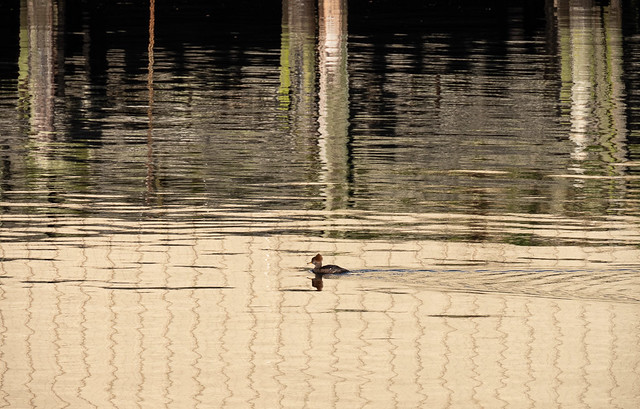
This Black Turnstone (I looked it up later) was skittish and didn't really want its picture taken. In flight it had a beautiful pattern on its wings. I took photos of related Ruddy Turnstones in Belize last winter.

This crow was working on getting the marrow out of a bone of some sort. It didn't care if I took photos of it. (That's frost on the wood.)

Across the bay I spotted the white head of a bald eagle in a tree but it was too far away for decent photos. There were also jelly fish floating in the water beside the dock.
This sparrow (Lincoln's?) was also a cooperative subject, although it didn't stay in one spot for very long.
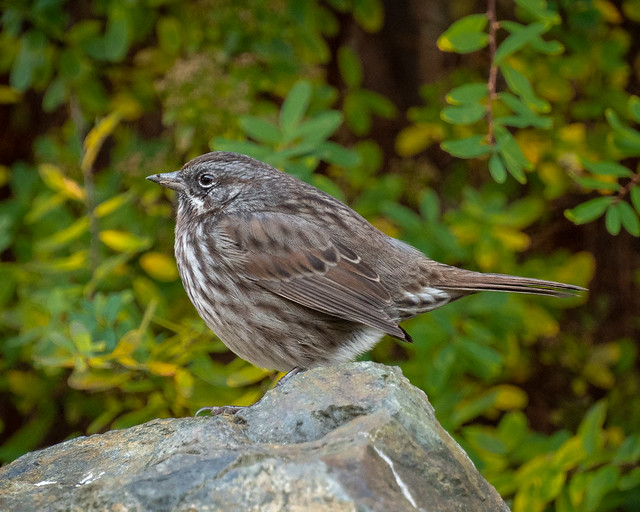
We visited the Ucluelet aquarium quite a few years ago when it was in the previous tiny building. At that time they were raising money for a new building (we donated). It was nice to see the new building - quite an improvement. It's not a huge fancy aquarium like the Vancouver one, but it's run by a non-profit society and it's interesting because it's a catch and release aquarium so everything is local. One of the tanks has been running for years. It started out with a bare chunk of concrete. The water is circulated from the ocean and the concrete is now completely covered and encrusted with a huge variety of creatures that colonized it from the water.
I would have loved to take more photos, but the sides of the tanks weren't very clear and taking photos through the surface doesn't work that great.
This sea urchin was poking out of the water, and very colorful.

A different anemone from the kind you see in the tide pools

And this starfish was just below the surface. The details on these creatures are fascinating.
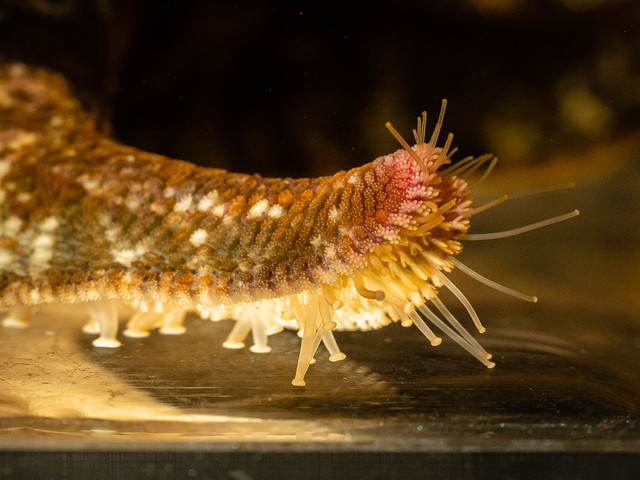
This is a closeup of the top of a starfish

I didn't quite manage to get all of this snail in focus

We had lunch at the Black Rock Oceanfront Resort restaurant that had a great oceanfront view.
We also did a few hikes in the area on the Wild Pacific Trail. It doesn't seem fair that the Salal is flowering when it's full on winter at home.
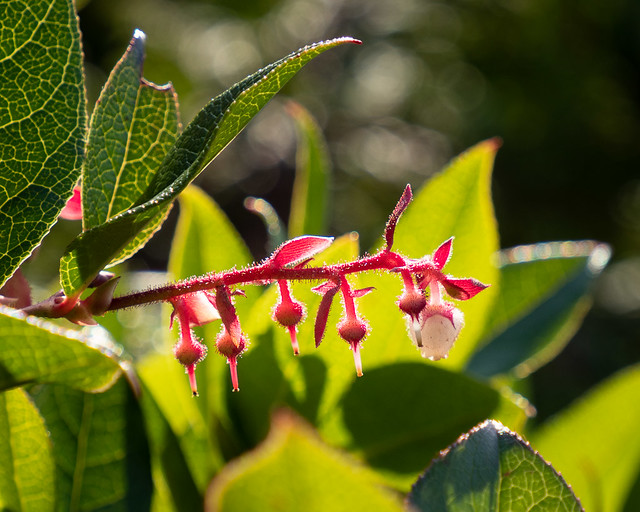
This looks a bit like another flower, but I think it's just leaves changing color

The sun was melting the frost on these cedar branches

Another Bald Eagle in the distance. When we tried to move closer it flew away.
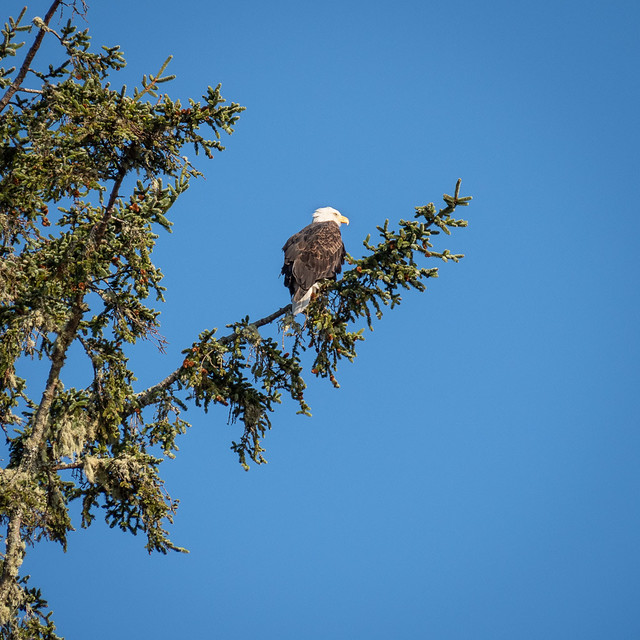
And a few reflection shots because I can't resist them. This is the reflection of a log


See all 16 photos in this album
Interesting reflections with a common merganser going by

This Black Turnstone (I looked it up later) was skittish and didn't really want its picture taken. In flight it had a beautiful pattern on its wings. I took photos of related Ruddy Turnstones in Belize last winter.

This crow was working on getting the marrow out of a bone of some sort. It didn't care if I took photos of it. (That's frost on the wood.)

Across the bay I spotted the white head of a bald eagle in a tree but it was too far away for decent photos. There were also jelly fish floating in the water beside the dock.
This sparrow (Lincoln's?) was also a cooperative subject, although it didn't stay in one spot for very long.

We visited the Ucluelet aquarium quite a few years ago when it was in the previous tiny building. At that time they were raising money for a new building (we donated). It was nice to see the new building - quite an improvement. It's not a huge fancy aquarium like the Vancouver one, but it's run by a non-profit society and it's interesting because it's a catch and release aquarium so everything is local. One of the tanks has been running for years. It started out with a bare chunk of concrete. The water is circulated from the ocean and the concrete is now completely covered and encrusted with a huge variety of creatures that colonized it from the water.
I would have loved to take more photos, but the sides of the tanks weren't very clear and taking photos through the surface doesn't work that great.
This sea urchin was poking out of the water, and very colorful.

A different anemone from the kind you see in the tide pools

And this starfish was just below the surface. The details on these creatures are fascinating.

This is a closeup of the top of a starfish

I didn't quite manage to get all of this snail in focus

We had lunch at the Black Rock Oceanfront Resort restaurant that had a great oceanfront view.
We also did a few hikes in the area on the Wild Pacific Trail. It doesn't seem fair that the Salal is flowering when it's full on winter at home.

This looks a bit like another flower, but I think it's just leaves changing color

The sun was melting the frost on these cedar branches

Another Bald Eagle in the distance. When we tried to move closer it flew away.

And a few reflection shots because I can't resist them. This is the reflection of a log


See all 16 photos in this album
Tofino
It's a bit of a drive from Victoria to Tofino (5 hrs) but it's quite a different feel on the exposed west coast of Vancouver Island, with the waves rolling in from the open Pacific, and big forest.
I took a ton of wave photos, trying to capture some of the feel of them. These weren't very big waves, but still impressive.

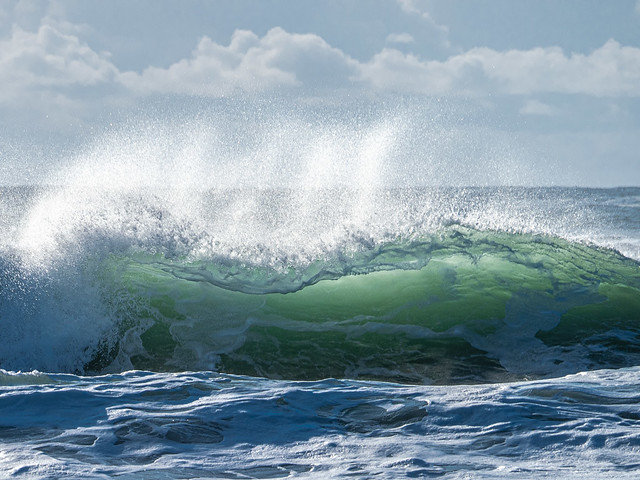

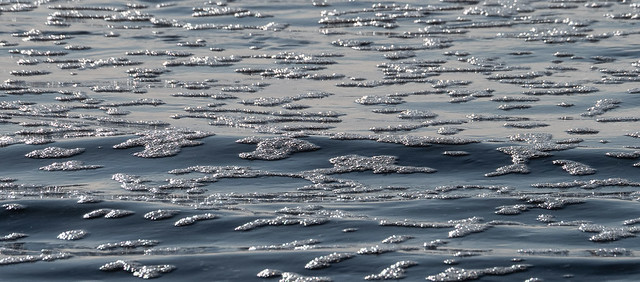
There weren't many birds around. Apart from the gulls, these Black Oystercatchers were one of the few we saw.

Since I was a kid and we came to the coast for summer holidays I've loved searching for life in the tide pools. I'm not sure if it was the time of year, or location, or the state of the world, but I didn't find a lot this time. There were a few anemones and a lone starfish, barnacles and mussels, sea weed, and not much else.


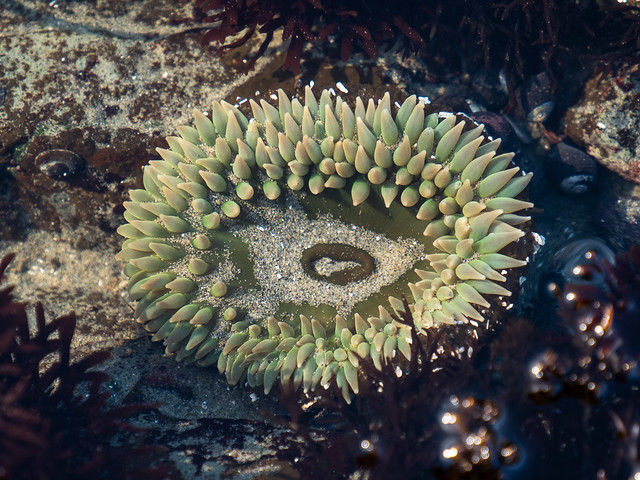
No shortage of barnacles:

I always enjoy the abstract aspects of the beach that the sand and water produce. This was spray from the waves in front of seaweed on the rocks:


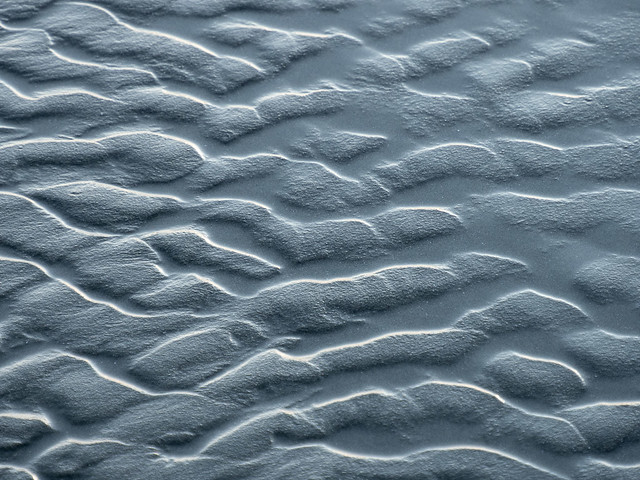





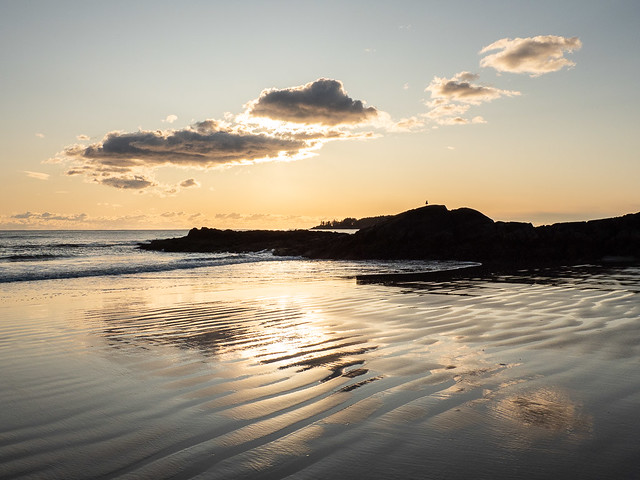
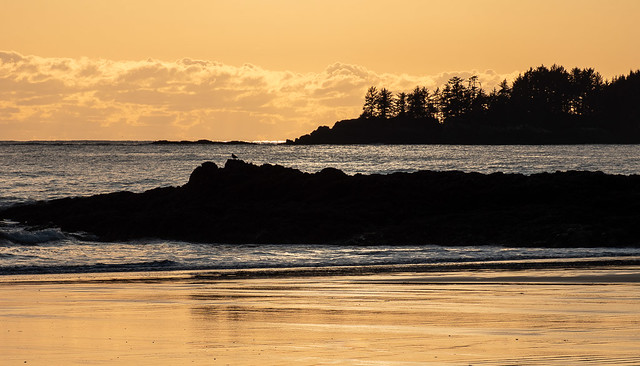
See all 35 photos in this album
I took a ton of wave photos, trying to capture some of the feel of them. These weren't very big waves, but still impressive.




There weren't many birds around. Apart from the gulls, these Black Oystercatchers were one of the few we saw.

Since I was a kid and we came to the coast for summer holidays I've loved searching for life in the tide pools. I'm not sure if it was the time of year, or location, or the state of the world, but I didn't find a lot this time. There were a few anemones and a lone starfish, barnacles and mussels, sea weed, and not much else.



No shortage of barnacles:

I always enjoy the abstract aspects of the beach that the sand and water produce. This was spray from the waves in front of seaweed on the rocks:










See all 35 photos in this album
Saturday, November 30, 2019
Running
We’ve done pretty well getting out running this trip. Hotel treadmill in Lethbridge, 9 km at Burrowing Owl, 6 km in the rain in Victoria, and then a 28 km long run to Oak Bay and back. The long run went ok, but it was a bit slow and I didn’t feel great. Afterward my left foot and right knee hurt, although not badly. Luckily they were fine on our hikes.
By the time we got to Tofino my foot and knee were better. When we headed out I was thinking an easy 10 km. I ran with Shelley for the first 2.5 km at an easy pace After Shelley split off I sped up till my heart rate was just under 120. I saw a sign for the information center so I decided to turn around there to make 12 km. (That also turned out to be the end of the multi-use trail.) The last few kilometres I ran a bit faster. I felt good and was pleasantly surprised to finish with an average pace of 5:30/km at an average heart rate of 123.
Two days later we headed out again. This time I decided not to look at my watch. I started out with Shelley again and after she split off I tried to set a pace I could just keep up for the remaining 9.5 km. It felt good to go a little faster than usual. My foot hurt for a bit but went away after a while. I hit the turnaround still feeling good. About 2/3 of the way I started to wonder if I’d gone out too fast. It got a little harder and my breathing increased. Looking at the stats afterward my heart rate also started to climb. But it wasn’t bad and I focused on maintaining a fast cadence and a light foot strike. I like to try to run as quietly as I can, hoping that minimizes the impact on my body.
I had my watch set to buzz every kilometre but I lost count and I thought I only had a kilometre to go. Somehow that made it easier. By the time I figured out my mistake I was on the home stretch. It didn’t feel like I had much kick left but I did manage my fastest kilometre if only by a few seconds. (So I guess I didn't go out too fast.)
Finally I let myself look at the numbers on my watch. I had managed my fastest times (since getting this watch) of 24:30 for 5km and 50:30 for 10km. I’d been wondering if I could manage a 5k under 25 minutes. I didn’t quite make 10km under 50 minutes but very close, especially since .5 km of it was still warmup. Of course, once upon a time I could run a lot faster than that, but that was then and this is now. Just as important was that I did it without killing myself. In fact I felt great afterward. I was also happy with my other stats - my average heart rate was 131, my cadence averaged 176, and my stride length and ground contact time were better than usual.
Speed generally isn't my focus. Most of the time I aim for a target heart rate and just try to run as efficiently as I can. I'd rather increase my distance and stay injury free than concentrate on speed. To paraphrase Michael Pollan, Run lots. Mostly slow. Occasionally fast. (his food version is: Eat food. Not too much. Mostly plants.) Of course, the definitions of "lots", "slow", "fast", and "occasionally" are highly variable. Regardless, once in a while it's nice to unwind a little.
I'm not sure why this random run in the middle of traveling turned out to be one of my recent best. It was an easy route - paved, flat, straight. And cool temperatures. And I'd been getting lots of sleep and low stress, plus a fair amount of hiking and running. Whatever the reason, I was happy with it.
By the time we got to Tofino my foot and knee were better. When we headed out I was thinking an easy 10 km. I ran with Shelley for the first 2.5 km at an easy pace After Shelley split off I sped up till my heart rate was just under 120. I saw a sign for the information center so I decided to turn around there to make 12 km. (That also turned out to be the end of the multi-use trail.) The last few kilometres I ran a bit faster. I felt good and was pleasantly surprised to finish with an average pace of 5:30/km at an average heart rate of 123.
Two days later we headed out again. This time I decided not to look at my watch. I started out with Shelley again and after she split off I tried to set a pace I could just keep up for the remaining 9.5 km. It felt good to go a little faster than usual. My foot hurt for a bit but went away after a while. I hit the turnaround still feeling good. About 2/3 of the way I started to wonder if I’d gone out too fast. It got a little harder and my breathing increased. Looking at the stats afterward my heart rate also started to climb. But it wasn’t bad and I focused on maintaining a fast cadence and a light foot strike. I like to try to run as quietly as I can, hoping that minimizes the impact on my body.
I had my watch set to buzz every kilometre but I lost count and I thought I only had a kilometre to go. Somehow that made it easier. By the time I figured out my mistake I was on the home stretch. It didn’t feel like I had much kick left but I did manage my fastest kilometre if only by a few seconds. (So I guess I didn't go out too fast.)
Finally I let myself look at the numbers on my watch. I had managed my fastest times (since getting this watch) of 24:30 for 5km and 50:30 for 10km. I’d been wondering if I could manage a 5k under 25 minutes. I didn’t quite make 10km under 50 minutes but very close, especially since .5 km of it was still warmup. Of course, once upon a time I could run a lot faster than that, but that was then and this is now. Just as important was that I did it without killing myself. In fact I felt great afterward. I was also happy with my other stats - my average heart rate was 131, my cadence averaged 176, and my stride length and ground contact time were better than usual.
Speed generally isn't my focus. Most of the time I aim for a target heart rate and just try to run as efficiently as I can. I'd rather increase my distance and stay injury free than concentrate on speed. To paraphrase Michael Pollan, Run lots. Mostly slow. Occasionally fast. (his food version is: Eat food. Not too much. Mostly plants.) Of course, the definitions of "lots", "slow", "fast", and "occasionally" are highly variable. Regardless, once in a while it's nice to unwind a little.
I'm not sure why this random run in the middle of traveling turned out to be one of my recent best. It was an easy route - paved, flat, straight. And cool temperatures. And I'd been getting lots of sleep and low stress, plus a fair amount of hiking and running. Whatever the reason, I was happy with it.
Friday, November 29, 2019
Salmon
Salmon are interesting fish. They are anadromous - as adults they live in the ocean, but they lay their eggs in freshwater streams. The young fish hatch and grow in fresh water before returning to the ocean. As adults they (mostly) return to the same stream where they were born. They use a sense of smell/taste to find their way back. All Pacific salmon and most Atlantic salmon die after spawning. Salmon are related to trout, char, and grayling.
We stopped briefly at Goldstream Park just north of Victoria. To the locals, the salmon are nothing special, they come every year, but it was new to me. All the dead salmon were attracting lots of feasting gulls. Bald eagles, bears and other animals also come to feed, but we didn't see any. It's mostly Chum Salmon, although there are also some Coho and Chinook as well as Steelhead and Cutthroat trout. These salmon don't have far to swim upstream, but some salmon travel as far as 1400 km to reach where they spawn.
All the dead, decaying, and half eaten salmon seem a little gruesome (and smelly!) but it's a natural cycle that has many side benefits. The dead salmon are eaten by wildlife and end up bringing nutrients from the ocean to the forest.





At first I thought all the salmon were dead, but then I realized there were quite a few still alive and swimming in the river.
We stopped briefly at Goldstream Park just north of Victoria. To the locals, the salmon are nothing special, they come every year, but it was new to me. All the dead salmon were attracting lots of feasting gulls. Bald eagles, bears and other animals also come to feed, but we didn't see any. It's mostly Chum Salmon, although there are also some Coho and Chinook as well as Steelhead and Cutthroat trout. These salmon don't have far to swim upstream, but some salmon travel as far as 1400 km to reach where they spawn.
All the dead, decaying, and half eaten salmon seem a little gruesome (and smelly!) but it's a natural cycle that has many side benefits. The dead salmon are eaten by wildlife and end up bringing nutrients from the ocean to the forest.





At first I thought all the salmon were dead, but then I realized there were quite a few still alive and swimming in the river.
Thursday, November 28, 2019
Raptors
Some photos from Pacific Northwest Raptors near Duncan, BC (on Vancouver Island). Most of the time captive birds are in cages and it's hard to get decent photos. But here there were quite a few either being held or tethered.
I think this is a Gyrefalcon, but I notice on the website they have a gyrefalcon/peregrine cross (they are closely related)

This is a Black Vulture, similar to a Turkey Vulture. This was shot through cage mesh, but it worked out reasonably well.

I always like to see American Kestrels. They are such beautiful little birds.

This is a Saker Falcon from Eurasia, used for falconry for thousands of years.

Harris's Hawks are one of the only hawks to hunt in groups.

We only saw Bald Eagles from a distance on this trip, so it was nice to see these ones up close. It was quite close to the walkway, and there was a dark shed behind it for a nice clean background.


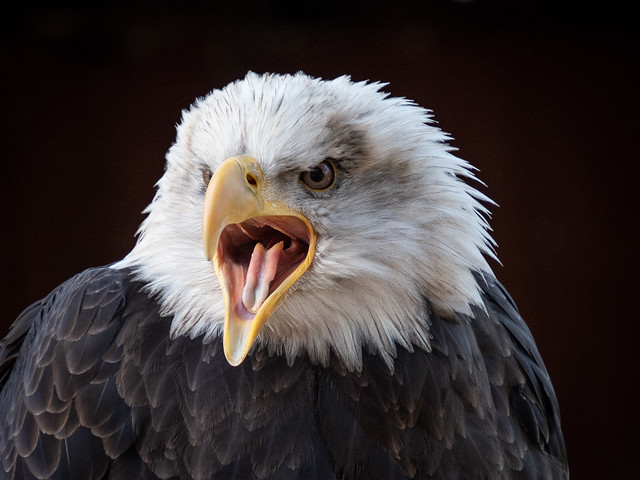
A Great Horned Owl:

Although they're not raptors, there were also a pair of Kookaburras (from Australia). This one had just washed and was still a little damp. They are related to kingfishers (as you can tell from their appearance.

These photos were all taken handheld with the Olympus EM1m2 with the 12-200 (24-400 equivalent) lens. I'm still getting used to the camera, I'm quite impressed with it's performance. And I love the small size. The micro four thirds sensor (2x crop factor) means the lenses are much smaller and lighter.
See all 20 photos in this album
I think this is a Gyrefalcon, but I notice on the website they have a gyrefalcon/peregrine cross (they are closely related)

This is a Black Vulture, similar to a Turkey Vulture. This was shot through cage mesh, but it worked out reasonably well.

I always like to see American Kestrels. They are such beautiful little birds.

This is a Saker Falcon from Eurasia, used for falconry for thousands of years.

Harris's Hawks are one of the only hawks to hunt in groups.

We only saw Bald Eagles from a distance on this trip, so it was nice to see these ones up close. It was quite close to the walkway, and there was a dark shed behind it for a nice clean background.



A Great Horned Owl:

Although they're not raptors, there were also a pair of Kookaburras (from Australia). This one had just washed and was still a little damp. They are related to kingfishers (as you can tell from their appearance.

These photos were all taken handheld with the Olympus EM1m2 with the 12-200 (24-400 equivalent) lens. I'm still getting used to the camera, I'm quite impressed with it's performance. And I love the small size. The micro four thirds sensor (2x crop factor) means the lenses are much smaller and lighter.
See all 20 photos in this album
Subscribe to:
Posts (Atom)
